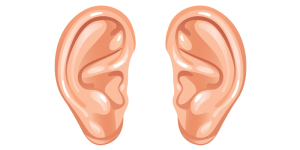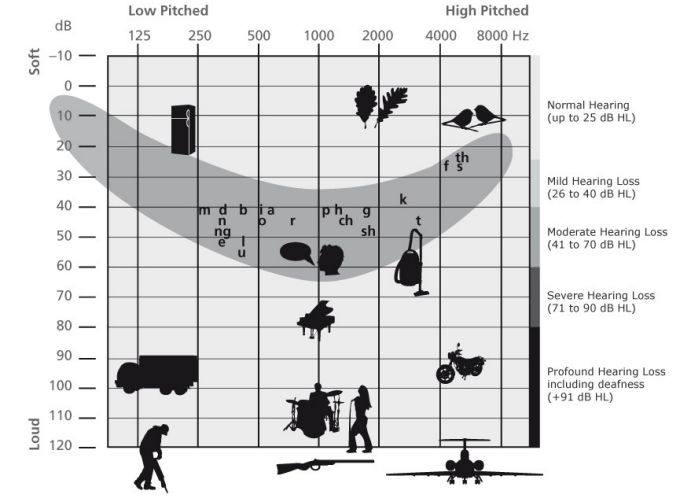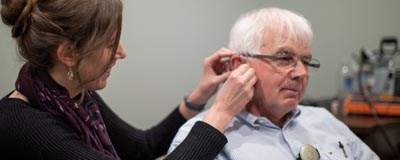Understanding Hearing Loss
Hearing is fundamental to most human communication. As with so many of the processes of the body, when it is working we completely take it for granted. However, when it isn’t working as well, it can have large implications in our daily life. Our hearing system is actually incredibly complicated, and small changes can lead to large effects in ones ability to communicate.
Our aim for this page is to provide you with a good overview of how the hearing system works, what can cause it to go wrong, and some of the implications in that. We have tried to answer the most common questions that we receive in our clinics, but if there is a topic that you seem to think is missing, please let us know.
How the Ear Works
The human body is an absolutely astonishingly designed series of systems which all interact incredibly. How we hear is no different. The outer ear and ear canal are designed to capture sounds and are shaped specifically to amplify the speech frequency of sounds. This naturally helps to reduce some of the other environment sounds. As sounds funnel down the ear canal, they hit the ear drum at and cause it to vibrate. As the ear drum vibrates, it moves the three smallest bones in the body, the malleus, the incus, and finally the stapes, which together are known as the ossicular chain. The sound waves are further amplified through the ossicles before arriving at the oval window of the cochlea. As the oval window vibrates with the bones, it begins to move the fluid in the cochlea which causes the inner ear hair cells to vibrate. With a large enough stimulus, these hair cells transmit the signals to the auditory nerve. It is here where the physical sound is converted into an electrical impulse that the brain will receive and interpret.
Para uma experiência de apostas incomparável, acesse agora a https://mostbet365.com.br/. A plataforma oferece uma ampla variedade de esportes, jogos de cassino e e-sports, com odds vantajosas e promoções exclusivas para todos os tipos de apostadores. Não perca a chance de apostar em um ambiente seguro e confiável — visite https://mostbet365.com.br/ e comece a ganhar hoje mesmo!

Conductive Hearing Loss
A conductive hearing loss refers to the reduction of sound as it passes through the ear canal, ear drum, and the bones in the middle ear. There are several different factors which may cause this portion of the hearing system not to function at an optimal level. These include:
Microtia/Minotia – These are typically birth defects where the outer portion of the ear does not develop properly. Some individuals are born without an external ear or without an ear canal. In both of these cases, sound is not transmitted very well into the hearing system.
Solutions: The typical solutions for this type of hearing loss are 1) surgery to recreate the outer ear or 2) a bone anchored hearing aid.
Damaged Ear Drum – There are several different ways the ear drum can be compromised. The most obvious would be a hole in the ear drum.
Wax Blockage – If the wax blockage completely seals off the ear canal, it essentially works as an ear plug. We have seen wax provide a temporary mild to moderate hearing loss.
Solutions: Typically, a wax blockage occurs too deep in the ear canal for the individual to remove on their own, so it is recommended to seek medical treatment through one of our clinics or your family physician to have it removed.
Damaged Malleus/Incus/Stapes – Whether it is a break in the bone, or otosclerosis where the bones calcify and stiffen, if the ossicles of the middle ear are not transmitting the sound through as effectively, it will result in a reduction of ones ability to hear sounds.
Solutions: There are often surgeries which can be done to help correct for damage to the bones in the middle ear. The first step would be to speak to an Otolaryngologist (ENT Specialist) to discuss if surgery is a good option for you. If you decide that is not the best route, the good news is that hearing aids are typically very effective for this type of hearing loss.
Sensorineural Hearing Loss
This is by far the most prevalent type of hearing loss in adults, and it is typically the result of damage to the hair cells in the inner ear. We are born with thousands of hair cells in the cochlea, which are separated into two categories, There are the inner hair cells (roughly 3,500) and the outer hair cells (around 12,000). For humans, once damaged, both types of these hair cells do not regrow or repair themselves.

There are several ways that hair cells can be damaged. This includes the following:
Normal Wear and Tear: The aging process takes a toll on the hearing system just like all other cells in the body. Over time, the function of the cochlear hair cells tends to diminish with time.
Noise Exposure: Whether it is loud music, industrial noise, a cheering sports stadium, an ambulance siren or fire alarm, the world is a noisy environment. The extent to which noise damages hearing is directly related to the intensity of the sound and the duration of that noise.
Genetics: Some families are more predisposed to hearing loss.
Medications: There is a rather large list of ototoxic drugs that are currently or have previously been on the market. These include certain antibiotic families and chemotherapy drugs. A dosage of certain drugs can cause irreparable damage to the inner hair cells.
Illness: Certain diseases target and damage the inner ear. Meningitis is one such example, where it can lead to a severe to profound hearing loss in individuals.
Poor Diet: This one may shock you, but there is some new evidence suggesting that eating a poor diet has been linked to hearing loss. This is likely due to the hair cells not receiving proper nourishment, and thus developing premature deterioration.
This video by Signia shows what happens to hearing as hair cells become damaged.
(For a more scientific explanation on how hair cells work, follow this link)
Safe Noise Exposure Times
The following chart shows the amount of time it is safe to be in an environment without doing some irreversible damage to your hearing system.
Restaurant – 85dB – 8 hours
Band Rehearsal – 90dB – 2 hours
Power Tools – 100dB – 15 minutes
iPod at high volume – 105dB – 5 minutes
Sports Stadium – 108dB – 3 minutes
Chainsaw – 110dB – 1.5 minutes
Rock Concert – 110dB – 1.5 minutes
Ambulance Siren – 120dB – 9 seconds
Firearms – 140-160dB – immediate damage possible
Hearing With Both Ears

Basic Rule: If you have hearing loss in both ears, then you should have a hearing aid in each ear. We were meant to hear with both of our ears. Our brain actually relies on sound input from each ear in order to generate a complete picture of our sound environment. (i.e., to hear properly). If you are not sure about this, try plugging up one ear in various listening environment and see for yourself.
Research has found the following to be benefits of hearing with both ears:
- There is an increase in the overall loudness of sound – thus you don’t have to strain as hard to hear what is being said
- The ability to understand speech in the presence of background noise is improved
- At least one ear is always favourably situated no matter where the sound or speech is coming from
- The ability to determine the location of a sound source in space is significantly better
- The quality and richness of sound is improved
Most people with hearing difficulties have hearing loss in both ears. Therefore, binaural hearing aids are appropriate for most. It is only for a select few individuals that two hearing aids are not best. These situations include:
- Hearing loss only in one ear
- Hearing loss so severe in one ear that a hearing aid would be of no benefit
- Some medical condition which prevents one ear from being aided
Hearing with both ears will help you to hear the best of your potential. In order to determine if you could benefit from two hearing aids, contact us to make and appointment for a hearing evaluation.
Understanding the Different Levels of Hearing Loss
There are 5 different levels of hearing loss: mild, moderate, moderately-severe, severe and profound.
- Mild Hearing Loss (26 dB- 40dB): this type of hearing loss is often associated with the inability to hear soft sounds. These sounds often include rustling leaves, bird chirping, or the refrigerator humming. A person with a mild hearing loss often has difficulty hearing speech in noisy environments.
- Moderate Hearing Loss (41dB-55dB): This type of hearing loss causes difficulty hearing moderately loud sounds (sound under 41dB). People begin having difficulties with speech sounds, especially the higher frequency speech sounds like /f/, /s/, and /th/. In general, hearing speech with background noise becomes extremely difficult.
- Moderately-Severe Hearing Loss (56-70dB):This type of hearing loss causes difficulty hearing even normal conversation in quiet unless the person of interest begins to raise there voice. Difficulties in groups and in noise continue to become even greater as this group are no longer hearing sounds bellow a normal conversation level.
- Severe Hearing Loss (71dB-90dB): This type of hearing loss creates a communication boundary. People with severe hearing loss are unable to hear speech sounds unless they are produced very loudly. Often people have a hard time participating in group conversation, as listening and following along requires a lot of effort. People with this type of loss have now lost the ability to hear sounds that are produced under 71 dB.
- Profound Hearing Loss (91dB +): Some loud noises are still heard, however, communication is no longer possible even with increased effort. People with this type of hearing loss can no longer hear sounds that are produced under 91dB.

(Photo courtesy of Phonak)
Ototoxicity
When medications result in hearing loss, ringing in the ears, or balance disorders, they are known as ototoxic. Ototoxic medications are typically found in painkillers, antibiotics, anti-inflammatories and even cancer fighting medications. There are several factors that affect the severity of ototoxicity including dosage, course of treatment, genetics, age, dehydration, kidney and liver functions are the main factors to consider. Ototoxic medications are typically used to treat serious illnesses. Read our ototoxic medications blog post to find out the most common ototoxic medications to watch out for. Your doctor should consider the effects of the medication on your hearing and balance systems before prescribing ototoxic medications.
Our Recent Blog Posts Related to Hearing Loss
These are our three most recent blog posts in the “Hearing Loss Tips” category. We are constantly adding more content to our blog. Many of our posts in this category focus on explaining different aspects of hearing loss. Others will provide tips and information to help those with hearing aids get the most out of their devices. To see our older blog posts, please visit our blog page. If you would like to see us cover any specific topic, please feel free to email us at info@davidsonhearingaids.com with your ideas.
The Real Impact Of Sensorineural Hearing Loss
It's More Than Just Not Hearing Sounds Unlike most of our blog posts about hearing loss, this specific one has been written with the family and friends of the hard of hearing in mind rather than the...
Should I Get My Hearing Tested In My 50s?
From loud concerts to busy work events and boisterous restaurants to listening to music at home, loud noises are more commonplace than ever. However, most people don’t realize the impact that the...
A Cochlear Implant Journey (Part II): New Sounds Await
A Hearing Story with Rob Meagher: This is the second post of our two part blog series speaking with Davidson Hearing Aid Centres' own Rob Meagher. If you haven't read the first part yet,...





